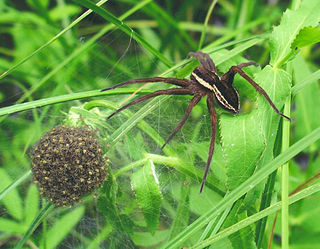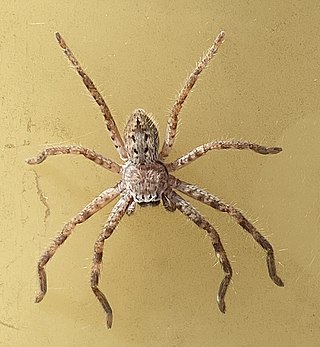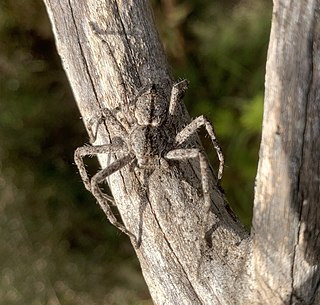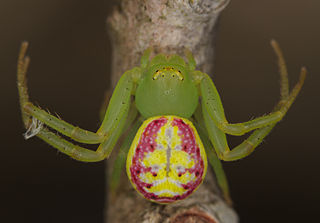
Huntsman spiders, members of the family Sparassidae, are known by this name because of their speed and mode of hunting. They are also called giant crab spiders because of their size and appearance. Larger species sometimes are referred to as wood spiders, because of their preference for woody places. In southern Africa the genus Palystes are known as rain spiders or lizard-eating spiders. Commonly, they are confused with baboon spiders from the Mygalomorphae infraorder, which are not closely related.

Dolomedes is a genus of large spiders of the family Pisauridae. They are also known as fishing spiders, raft spiders, dock spiders or wharf spiders. Almost all Dolomedes species are semiaquatic, with the exception of the tree-dwelling D. albineus of the southeastern United States. Many species have a striking pale stripe down each side of the body.

Barychelidae, also known as brushed trapdoor spiders, is a spider family with about 300 species in 42 genera.

Heteropoda is a genus of spiders in the family Sparassidae, the huntsman spiders. They are mainly distributed in tropical Asia and Australia, while at least one species, H. venatoria, has a cosmopolitan distribution, and H. variegata occurs in the Mediterranean.

Holconia is a genus of Southern Pacific huntsman spiders that was first described by Tamerlan Dahls Thorell in 1877. It was branched from Isopeda in 1990.

Argoctenus is a genus of South Pacific long-legged sac spiders first described by Ludwig Carl Christian Koch in 1878. They are found in Australia, New Zealand, and New Guinea. They resemble wolf spiders except for the narrowed carapace and the eye arrangement.

Arkyidae is a family of araneomorph spiders first described by Ludwig Carl Christian Koch in 1872 as a subfamily of Araneidae, and later elevated to a full family in 2017.

Beregama is a genus of South Pacific huntsman spiders that was first described by D. B. Hirst in 1990.

Isopedella is a genus of huntsman spiders that was first described by D. B. Hirst in 1990.

Neosparassus is a genus of huntsman spiders first described by Henry Roughton Hogg in 1903. Members of this genus most closely resemble those of Heteropoda, except that the cephalothorax is high, peaking between the midpoint and the eyes, before sloping toward the back. This angle causes the front of these spiders to appear more prominent than it actually is.

Pediana is a genus of huntsman spiders that was first described by Eugène Louis Simon in 1880.

Tharrhalea is a genus of crab spiders first described in 1875 by Ludwig Carl Christian Koch.
Storena is a genus of ant spiders first described by Charles Athanase Walckenaer in 1805.













